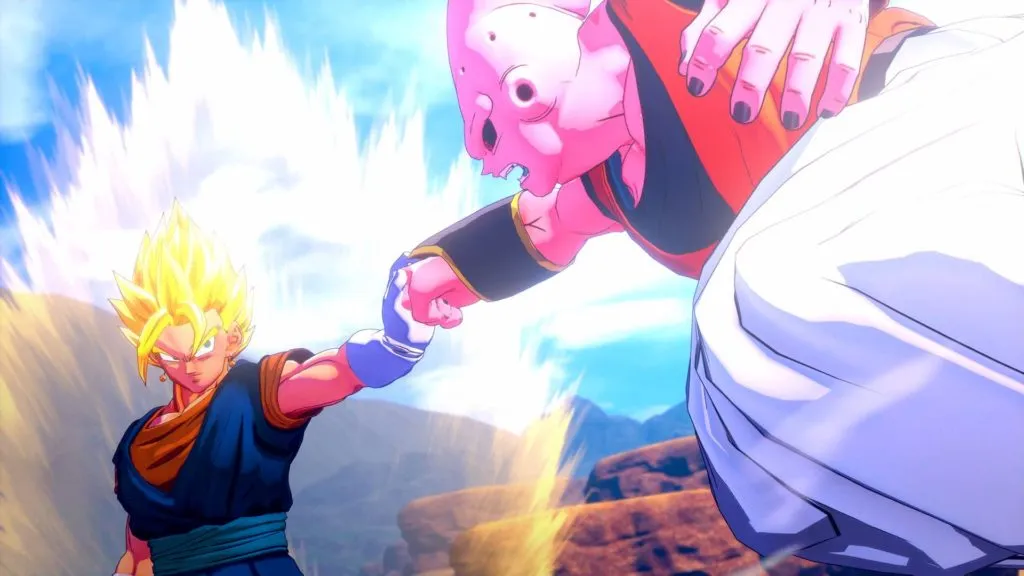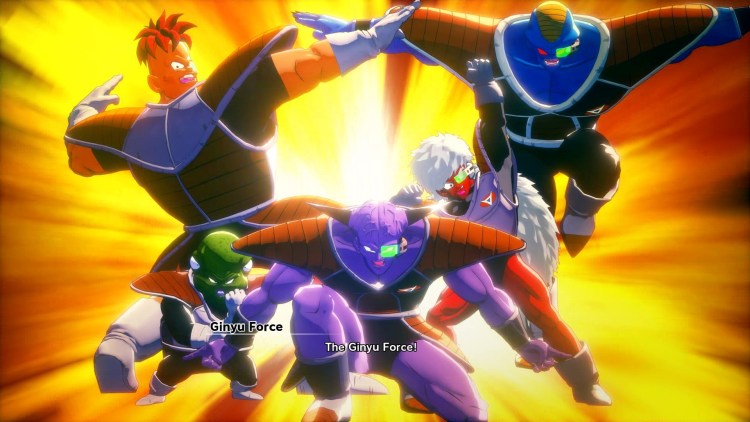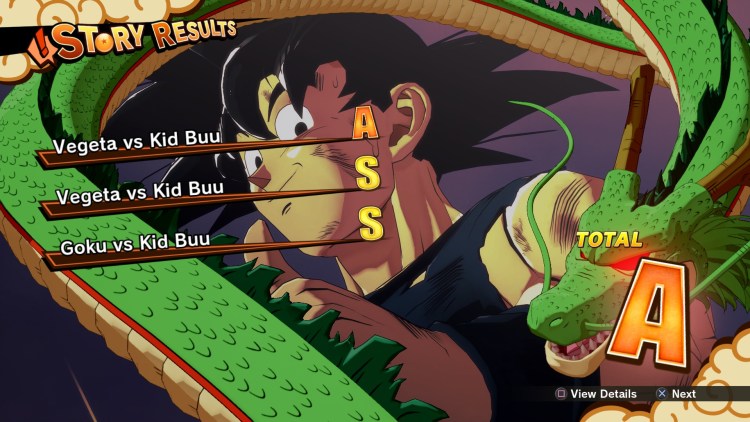Games have been retelling the story of Dragon Ball for more than a quarter of a century. Akira Toriyama’s beloved story about dudes randomly teleporting around and punching each other through entire mountains is well-trodden ground at this point. So much so that it seems more than a little redundant to keep doing it. However, Dragon Ball Z: Kakarot is doing it again all the same.
To be clear, no one needed this game. But it poses and answers a very important question for products based on licensed properties: can a mediocre game still be worth it if it offers the franchise’s fans exactly what they want? The answer here is a resounding yes. Make no mistake, Dragon Ball Z: Kakarot is a mediocre game. The combat is okay, the graphics are acceptable, and the world is mostly empty and filled with pointless fluff. But it’s made with so much love for the source material and loaded with fanservice to the point that fans are going to likely have a great time regardless. But I can’t say the same for everyone else.
This time on the last episode of Dragon Ball Z
It’s been nearly 24 years since Dragon Ball ended and games set in the franchise need to move on. There’s new canon material to cover and these older storylines have been beaten to death by this point. Dragon Ball Z: Kakarot tells the story that you almost certainly already know. But it does it with more attention to detail and more granularity than any game before it. Even if the story is well-worn, this is the best adaptation it has ever gotten from a game. And I hope that there’s no need for another developer to try the same thing again.
All of the main arcs associated with the Z saga are present here, as they almost always are. But nearly every major story beat is now present. If you’ve ever said to yourself, “Man, I remember when Piccolo left Gohan unripened apples on the top of that cliff. I sure wish a game would let me pick those apples myself and then give them to Gohan!” then you’re probably part of a very small group. But that happens here. Because almost everything happens here.
That being said, the game does skip over some details and changes others. But, regardless, we’re left with a huge amount of story that does a pretty excellent job of presenting the material. You could make someone who knows nothing of Dragon Ball play through it and have them walk away pretty much knowing damn near everything. And that’s the kicker. If playing through an overly-detailed version of volumes 17-42 of the manga is something you want to experience, you’ll probably love this game in spite of its many issues.
Grant me your energy!!!
Dragon Ball Z: Kakarot puts you in the shoes of several characters as they make their way through the story. Who you play as will change regularly based on what’s happening and who’s currently dead. Two of the unique characters can only be used twice and once, respectively, which is weird. The game isn’t open-world but is instead divided into several large zones. You’ll make your way through these by flying at breakneck speeds just like in the source material. You’ll mostly be flying to and from story markers, either for the main quest or the game’s many side ones.
Unfortunately, there isn’t much to do in these zones. There are plenty of items to harvest, such as food ingredients that you can get from trees and crops or by catching animals. There are also ores and mechanical parts that can be found strewn about. Plus, you can even do time attacks in two vehicles, go fishing, or play a batting game. All things I’m positive every Dragon Ball fan has been longing to do.
In case you’re very bad at detecting sarcasm, a massive amount of the things Dragon Ball Z: Kakarot offers are neither relevant to the source material or purposeful. The ingredients are used to cook items that give you mostly irrelevant stat boosts. The parts are used to build and improve the vehicles you can make or to unlock new training exercises. Most of the characters you can interact with will also give you coins that you can put on boards tied to various minor stat increases. These too offer very little benefit. The vast majority of this content can be easily ignored.
It also bills itself as a bit of an RPG, but it definitely isn’t. There are stats, but they’re not important and characters typically get leveled up automatically.
Kaaaaa Meeeeeee Haaaaaaa Meeeeeeee
And then there’s the combat. Fighting is one of the main draws of any Dragon Ball game, it’s true. But it isn’t here, not really. Sure, you’ll progress the story through battles and enemies prowl the maps, waiting to chase after you if you get too close. But the fighting doesn’t capture the ridiculously fast, pressure-filled fights of the source material.
Reading the manga or watching the anime shows the characters hitting each other at the same time at high speeds. They’re constantly blocking and dodging while appearing to teleport from one spot to the next. I’ve played a lot of the games, but have never seen a 3D one come close to offering the same look or feel. Dragon Ball Z: Kakarot plays very similarly to the Xenoverse games, albeit faster and more in line with what you’d expect.
But it’s way too simple to stand on its own. Almost all fights play out the same way. You rush at your enemy and hit them with melee attacks or energy blasts until they glow red. Then you either dodge away or block until their attack is over so that you can hit them again.
But the enemies have hyper armor whenever they use special attacks, so you can’t flinch them. I’d imagine this exists to stop you from being able to stunlock your foes for the entirety of fights like you can in other games. And it accomplishes that, sure, but it does so at the cost of making things tedious and inexplicable.
No even footing
Why inexplicable? Because the player and the AI operate by totally different rules. Yes, they get hyper armor anytime they go to attack you. But you only get hyper armor for a second or so if you enter your powered-up state. It feels kind of ridiculous, especially when you’re fighting weaker enemies. If Super Saiyan Goku hits a Saibaman with a kamehameha, it’s flat-out weird to see them just take it to the face without budging.
You only have one melee button at your disposal this time. You can also fire smaller ki blasts with another button, as per usual. Additionally, you can have four special attacks equipped at once, plus maneuvers that let you push your enemies away or immediately teleport behind them to avoid dangerous attacks. All of those use ki, which can be recharged whenever you need to as long as you’re not getting hit. Just like with enemy specials, you can’t flinch them while they’re charging, but if you get hit, you’ll stop completely.
Naturally, there are also transformations. All of the playable cast, save for Piccolo, are Saiyans, so they can all go Super Saiyan or use similar transformations. Most of these drain ki while active but increase your overall damage. Everything works, for the most part, but I wish it went further. And I wish that the fights didn’t almost all feel so interchangeable. Regardless of if you’re fighting Pilaf’s robots, Frieza, or Cell, it typically all feels the same.
Missed cinematic opportunity
Famous fights are usually entirely lacking in-game references to iconic moments during. They show up occasionally, such as when you hit Frieza so hard he makes a ridiculous face if you stop him from charging a very specific attack. But Dragon Ball Z: Kakarot makes very spare use of the kind of dramatic, cinematic shots that other games have had in spades. To even activate these you need to either attack an enemy while in your powered state or stun them first. And stunning them takes too long and frequently isn’t worth the effort, so the shots are rare.
Then there’s the overall lack of difficulty. For the majority of its duration, the game is just easy. Granted, the combat isn’t mechanically complex enough to offer a challenge, but that’s no excuse for some of the series’ rawest fights to be such surprising pushovers. And the difficulty jumps around at weird times. For instance, when you fight Recoome as Gohan, the fight offers very little threat or resistance, even though Gohan is meant to be struggling for survival. Then Goku shows up. Even though he’s supposed to be able to easily dispatch Recoome with minimal effort, he instead becomes much more of a threat to Goku than he was to Gohan.
Then you fight Frieza and he’s even less of a threat. It robs a lot of the story moments of their power. As enjoyable as experiencing the story in Dragon Ball Z: Kakarot can be, it would have been even better had the fights themselves correlated with the narrative they were meant to represent. If I’m making it sound awful, it isn’t. But I just don’t see why they couldn’t have done a bit more on this front.
Like running Snake Way
Even ignoring all of the fluff the game’s zones are packed with, Dragon Ball Z: Kakarot is a very long game. I’m honestly kind of glad the zones aren’t loaded with typical modern trappings. It took me around 44 hours to hit the end credits with very little time spent on collecting ingredients or trying to upgrade my hovercar. I did do almost all of the sidequests up to that point, however. Completing the rest of the sidequests will push most players up past the 50-hour mark. At the very least, you’ll be getting a lot of bang for your buck.
But a whole lot of that time will be spent on watching cutscenes. There are upwards of a dozen hours of story to sit through, which is very much the best part of the game. They mostly look okay, even if they suffer from a lot of recycled animations and obvious mouth flaps. Kakarot is one of those games where the animators didn’t give the character’s faces a laughing animation, so they just have the usual talking mouth flaps while their voice actor laughs.
The world does look fairly decent, though. More importantly, it does a great job of recreating Toriyama’s art in a 3D environment. It truly looks and feels like you’re flying around in the world of Dragon Ball. Famous series landmarks are also given persistent locations that exist in tandem with each other. This is the first time we’ve ever really seen this world built this way, as Toriyama didn’t exactly map anything out.
Get bugged
I do have to say, Dragon Ball Z: Kakarot has its fair share of serious bugs. Characters will sometimes slide away while you’re talking to them, leaving your character conversing with apparently no one. Some quest markers just won’t show up at all for no obvious reason. At one point, I had to stop playing the game and wait for someone to find a workaround, as a plot-necessary character wasn’t showing up at the marker, making progression temporarily impossible. I also had the game crash on me once or twice.
As far as PC ports go, this is par for the course compared to Bandai Namco’s other titles. You can change the resolution and a small handful of settings, but don’t expect extensive options. The game ran well for me, though. You can run the game up to 60 FPS, but no uncapped setting currently exists. Be warned, though, because if you have Vsync on while the game is full-screened, it’ll get locked at 30. You’ll need to set the game to Windowed to get Vsync at 60 FPS.
In the end, Dragon Ball Z: Kakarot is not worth playing if you’re not already a fan. Everything the gameplay has to offer is mediocre. But, for fans, it offers a loving, enjoyable experience. As someone who has been into the series for literal decades now, I had a great time when all is said and done. But if the idea of playing through this story isn’t appealing, then there’s no reason to jump in. However, if that is the case, this game wasn’t made for you anyway. And there’s nothing necessarily wrong with that, as the majority of the fans who pick it up are going to be satisfied.
















Published: Jan 22, 2020 11:00 PM UTC